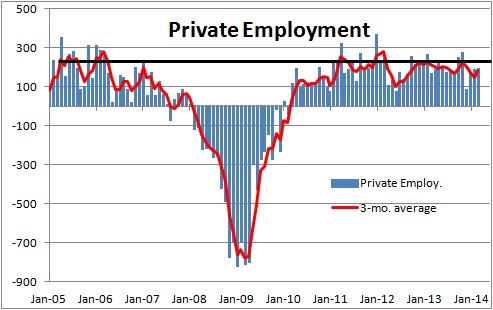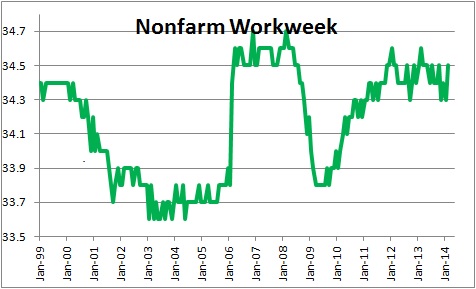April 4, 2014
The winter was very long and brutal. Month after month the economic statistics were depressing. Economists kept suggesting that the bulk of the drop-off in activity was weather-related. But that story was getting old and the longer it continued the more likely it became that other factors were at work. Happily, the employment statistics for March provide solid evidence that the early year slowdown was, in fact, weather related and that the economy is rebounding nicely as spring gets underway.
Hiring in March rose 192 thousand which was about as expected and there were modest upward revisions to January and February. As a result, private sector employment increased 182 thousand per month in the first three months of the year which is roughly in line with the gains that were being reported prior to the onset of bad weather. Thus, the trend rate of increase in jobs still appears to be about 200 thousand. We have often pointed out that employment rarely increases by more than 225-250 thousand per month for any protracted period of time. We are close.
The real story in the employment report was the increase in the workweek in March.
In any given month employers can boost output either by additional hiring or by extending the number of hours that their employees work. In March the nonfarm workweek jumped by 0.2 hour to 34.5 hours. . That may not sound like much. However, the 0.2 hour increase in the workweek in March has the same impact as hiring an additional 800 thousand workers. Put another way, if instead of lengthening the workweek firms had simply chosen to hire more workers, they would have needed to hire almost one million workers in March to produce the same amount of goods and services.
In the manufacturing sector the workweek rose by 0.3 hour to a record high level. Factory overtime hours increased by six minutes to a record high level. Quite clearly the factory sector is poised for a substantial upswing in activity both in March and the months ahead.
In construction employment increased by 19 thousand and the workweek jumped by a full 1.0 hour to 39.1 hours.
Perhaps the easiest way to understand all this is to focus on something called the “aggregate hours index.” If we know how many people are working each month and how long they worked, we should be able to get some idea of how many goods and services they produced. That is important because that is exactly what GDP measures. Thus, this series can be a rough monthly proxy for GDP. Since the recovery began in the middle of 2009 this index has moved steadily upwards. When the bad weather began in December the index dropped off accordingly. It continued to be unimpressive in January and February as snowstorms and cold weather swept across the country. But as the weather finally returned to normal in March the index surged as employment quickened and the workweek got longer.
The chart suggests that GDP probably rose a bit more slowly in the first quarter as the weather took its toll. We currently estimate that it rose at a modest 1.9% pace in that quarter after having climbed by 2.6% in the fourth quarter. But given that our monthly proxy of GDP growth ended the quarter on such a high note and is likely to rise farther in the months ahead, it is quite likely that our estimate of 3.5% GDP growth in the second quarter may not be far off the mark.
Meanwhile, the unemployment rate was unchanged in March at 6.7% which was expected. But what is significant is that it remained steady even though the labor force surged by 503 thousand in that month. Household employment almost kept pace and climbed by 476 thousand. As a result, the number of unemployed workers rose by just 27 thousand. Many economists have suggested that the unemployment rate has been falling simply because workers are becoming discouraged and dropping out of the labor force. But that is not a valid argument. During the past year the labor force has risen 94 thousand per month which is very much in line with its historical average of about 100 thousand per month. In addition, the number of discouraged workers is actually falling. Let’s lay to rest the notion that the decline in the unemployment rate is simply some statistical anomaly. It is real and it is declining because the economy is creating jobs.
It is one thing for economists to say that the seemingly never ending string of soft data was merely a reflection of the weather. The longer the bad news continued the more likely it became that the explanation was off the mark. Fortunately, the March data confirm that we were on the right track all along. Keep in mind that this good news will continue throughout the month as measures of production, construction, housing starts, and income will be similarly impacted.
The good news may not last, but it sure feels good at the moment – just like the weather! Enjoy it while you can.
Stephen D. Slifer
NumberNomics
Charleston, SC






Follow Me